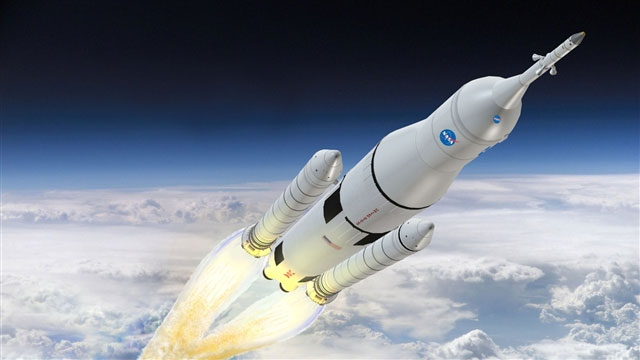NASA creates hundred-ton rockets that collect specimens from planets
NASA plans to build a kind of heavy missile based on the space launch system (SLS), which can fly far above planets near the Earth like the Moon or Mars, to come and bring specimens. from distant planets like the moon of Pluto to Earth.

Image simulating super SLS rocket. (Photo: Boeing)
The missile can weigh from 70 tons to 130 tons, tasked with launching unmanned aerial vehicles onto Pluto's moon Charon, or taking specimens from Jupiter's moon Europa, star moon Titan Earth.
It is expected that the first flight of the SLS missile will be launched on Earth's low orbit in 2017 with a 70-ton version. Starting in 2022, it is expected to launch a 130-ton SLS rocket. The missile's diameter is about 8.4 meters, carrying a 10-meter-diameter cone and SLS system with a load of 1,100 cubic meters.
In it, the conical nose will allow bringing specimens from the outer planets back to Earth for research. Also carrying such a large scientific spacecraft can help combat the harsh radiation environment on planets.
- Specimen worth 800 million USD
- NASA launched a meteorite research satellite that could destroy the Earth
- New NASA missions
- NASA uses a bow and arrow to shoot a comet
- About 50% of natural history specimens may be being mistakenly named
- The Curiosity ship drills a second nose on Mars
- Space sunflowers help take photos of the stars more clearly
- What does the Sun look like on other planets?
- People will settle on Mars in 2030
- NASA has discovered 3 planets smaller than Earth
- Two more decades will meet
- Hundreds of moon rocks missing
 Van Allen's belt and evidence that the Apollo 11 mission to the Moon was myth
Van Allen's belt and evidence that the Apollo 11 mission to the Moon was myth The levels of civilization in the universe (Kardashev scale)
The levels of civilization in the universe (Kardashev scale) Today Mars, the sun and the Earth are aligned
Today Mars, the sun and the Earth are aligned The Amazon owner announced a secret plan to build a space base for thousands of people
The Amazon owner announced a secret plan to build a space base for thousands of people